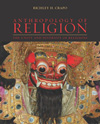
Diversity and Unity in the World's Religions |  |
Chapter Summary- All religious ideologies include a cosmogony that explains the origins of supernatural beings and powers, the universe, and human beings. Stories about the origin of supernatural beings and powers form a religion's mythology. The supernatural beings in those stories make up the pantheon of the religion.
- Religion inspires strong positive emotions, especially emotions that provide cathartic release from the stresses of life. Religious feelings are often expressed in rituals.
- All religions include piety values, values concerning good and bad behavior toward the supernatural realm. Moral values concerning the treatment of other human beings are found in some but not all religions.
- All religions involve ritual behaviors. Rituals are the instrumental part of religion, the means by which humans attempt to influence the supernatural realm. Rituals are performed both privately and in groups. By participating in the public ceremonies of religion, individuals proclaim their acceptance of the beliefs and values that they symbolize. Thus, participation in religious rituals can have a stabilizing influence on members of the religious community.
- All religions sometimes involve group activities, so religions can be described in terms of the ways in which their congregations are organized. Religious specialists include shamans, inspired part-time specialists who serve individual clients, and priests, religious specialists who serve congregations. The simplest religious social organization is that of the shamanic religion in which shamans perform rituals for individual clients when requested. Communal religions bring people together to perform group rituals. Ecclesiastical religions have priests who perform rituals at scheduled times for entire congregations.
- Religious belief and practice are tremendously diverse. This diversity arises because religion achieves its ends through symbolic action that aims at influencing nonhuman beings and powers to achieve those ends and because religion is less constrained by issues of practicality than are many of the nonreligious customs of a society.
|
|
|